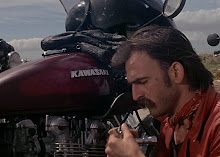If I asked you to guess the 70's four-cylinder bike I'm thinking of with 750 in its name, I can guarantee you'd say Honda CB750.
And you'd be wrong.
I'm thinking of something much more exotic. In fact, I'm thinking of something that cost almost twice as much when new than a CB750. It was an aristocrat's four-cylinder superbike, one dripping with racetrack engineering, pedigree and hardware.
I'm thinking of the MV Agusta 750S America.
The 750S America was an evolution of the stunning 750S, Count Agusta's race bike for the street. Except that it wasn't a race bike. Agusta was terrified of privateers buying the 750S, entering races and then losing, thus tarnishing the mighty MV Agusta name. To prevent this from happening, Agusta ordered the 787cc four to be neutered.
The cylinder head was filled with tiny valves, the engine was fed by tiny carbs, and the final drive was done via a shaft. Cheap rear shocks and a poor front drum brake were also added. What resulted was an overly expensive bike that would get beaten by the much-cheaper CB750 and absolutely slaughtered by the Kawasaki Z1.
To remedy this, MV went back to the shed and set out to give the 750S the performance it demanded.
First, the heavy front drum was replaced by twin discs. Next the engine was given a refresh. The tiny Dell'orto UB24 carbs were replaced by larger Dell'orto VHBs. Finally, the valves grew and so did the compression. What resulted was a bump in power from 66 hp to 75 hp and a 9,000 rpm redline. These changes allowed the 750 to finally reach its advertised 130 mph top speed. The shaft final drive and heavy weight remained but the bike had an overall more visceral feel to it.
Performance wasn't the only thing that was updated. To accentuate the new found power, MV gave the bike's styling a refresh. The rounded tank was replaced by a longer unit with more squared-off styling and large cutouts for the rider's knees. The classic bum-stop seat of the 750S was replaced with a square stop seat covered in brown suede. Nothing says 1970's chic like brown suede.
Over the next few years, the 750S America was treated to a number of changes. The spoked wheels were replaced by cast wheels and the silencers were redesigned. The four was eventually bored out to 837cc, which meant more power and more speed.
The MV 750 really came into its own at the hands of tuner Arturo Magni. Magni replaced the suspension with top-quality units and put the bike on a massive diet. The shaft drive was also tossed in favor of a chain. Magni's hands also found their way into the engine, which saw displacement rise to 861cc and power rise to 92 hp.
The plummeting weight and increasing power meant the 750 was getting closer to the street-legal race bike it should have been. Through continued evolution at the hands of the factory and tuning shops, the 750 was displacing 1,066cc and belting out 118 hp by the end of production in 1980.
So, then, it's hard to sum up the 750 and what makes it so special. It definitely was a uniquely Italian answer to the superbike question. At first glance, it seems to be a beautiful piece of Italian sculpture bolted to an industrial lump of sand cast aluminum. On paper, it was heavy, expensive and complex. In reality, it was heavy, expensive and complex. It was also a bit slow at first but that was quickly remedied.
So what is it? What is the MV 750?
I can tell you in one word: timeless.
The MV 750 is timeless in that it was totally exotic, totally different from every other motorcycle out there. It was very expensive and sold in minuscule numbers, quite in contrast to the cheap and hugely popular fours from Japan. And while the fours from Japan were raced, destroyed, ruined, chopped and thrown away, the MVs were kept and appreciated. These days, the fours that could run over the MV 750 are practically given away while the MV silently increases in value.
To sum it up, the MV 750 is as all great art is: a curious oddity when new and then a cherished piece when its time has passed.
Subscribe to:
Post Comments (Atom)

No comments:
Post a Comment